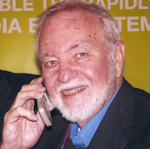DSP Chips Say To Radio: "Let's Get Digital"
Broadcast radio is going digital. Two of the last holdouts in the digital revolution, AM and FM radio, will get a digital mode thanks to a series of chips developed by Texas Instruments.
Such digital radio conforms to the new HD Radio standards developed by Ibiquity Digital Corp. The in-band, on-channel (IBOC) standard defines a digital mode for transmitting music and voice by digital means using the same frequencies and spectrum space as the current analog systems.
For less than about $100,000, stations can add the IBOC digital system, which operates together with the existing transmitter. While the Federal Communications Commission blessed the IBOC system in October 2002, practical and affordable hardware has taken a while to develop. The TI chips facilitate the implementation of a fully compatible AM and FM radio that conforms to the IBOC system.
The IBOC system defines sidebands above and below the regular analog sidebands. The audio is digitized, compressed, and modulated onto multiple carriers created as part of the orthogonal frequency-division multiplexing (OFDM) process. This complex modulation method uses the inverse fast Fourier transform (IFFT) to create the multiple carriers, which are modulated by BPSK, QPSK, 16QAM, or 64QAM. The only practical way to create such a signal is by digital signal processing. Of course, DSP is required to demodulate the signal. That's where TI's chips come in.
The TI DRI8201 is an analog front-end (AFE) conversion chip that takes the analog IF outputs from a tuner, usually at 10.7 MHz for FM and 455 kHz for AM, and digitizes them. The 12-bit analog-to-digital converter (ADC) runs at 80 Msamples/s. The digitized IF signals are then digitally downconverted and sent to the DSP baseband chip for demodulation.
The DSP chip is a specially programmed version of the company's widely used TMS320C6000 series. Called the DRI250, this baseband chip handles all of the demodulation with FFT, forward error correction and detection, interleaving, and decompression. Ibiquity supplies the DSP's software algorithms. The serial digital outputs are sent back to the DRI8201, where they're converted into analog by a pair of digital-to-analog converters (DACs). The DACs, in turn, drive the external power amplifiers (PAs).
AM now sounds more like current FM. FM now has CD-quality audio. Plus, both AM and FM benefit from the use of digital communications methods, meaning less noise, interference, fading, and degradation due to multipath effects.
Over 300 of the approximately 13,000 U.S. broadcast stations have signed up for HD Radio licenses. About 70 are already on the air, mostly in the larger U.S. cities. More stations will come on line as receivers become available. Kenwood now offers one of the first radios, and expect others to arrive from Panasonic, JVC, and Harmon Cardon.
Samples of the DRI250 and DRI8201 are available now, with volume production expected early this year. Sample pricing is $30 for the DRI250 and $8 for the DRI8201.
Texas Instrumentswww.ti.comIbiquity Digital Corp.www.ibiquity.com